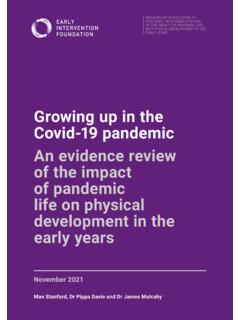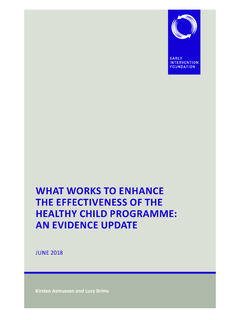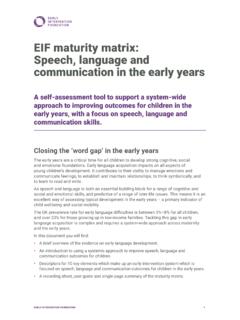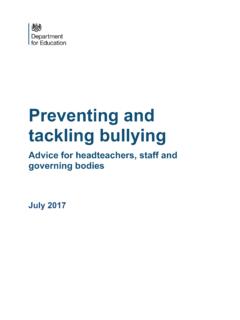Transcription of Adverse childhood experiences What we know, what we don’t ...
1 February 2020Dr Kirsten Asmussen, Dr Freyja Fischer, Elaine Drayton & Tom McBrideAdverse childhood experiencesWhat we know, what we don t know, and what should happen nextADVERSE childhood experiences : WHAT WE KNOW, WHAT WE DON'T KNOW, AND WHAT SHOULD HAPPEN NEXTE arly Intervention Foundation 10 Salamanca Place London SE1 7 HBW: E: T: @TheEIFoundation P: +44 (0)20 3542 2481 This paper was first published in February 2020. 2020 The aim of this report is to support policymakers, practitioners and commissioners to make informed choices. We have reviewed data from authoritative sources but this analysis must be seen as a supplement to, rather than a substitute for, professional judgment. The What Works Network is not responsible for, and cannot guarantee the accuracy of, any analysis produced or cited is a registered charity (1152605) and a company limited by guarantee (8066785).AcknowledgmentsWe would like to thank everyone who has contributed to this report through their thoughts, time and commitment.
2 This includes our advisory group members, Professors Vashti Berry, Andrea Danese, Eamon McCrory and Stephan Collishaw, who were instrumental in guiding the scope of the project and helping us sift through the literature. Their comments in drafting and proofing were also essential for ensuring the quality of the would also like to thank EIF colleagues for their hard work in contributing to the project and providing thoughtful challenge. This includes Stephanie Waddell and Jessica Ford, who conducted the interviews with external stakeholders at the start of the project, as well as Dr Jo Casebourne, Donna Molloy and Mark Ballinger, who provided critical guidance in drafting and clarifying our key document is available to download as a free PDF at: commercial use, please contact to shareThis document is published under a creative commons licence: Attribution-NonCommercial-NoDerivs UK EIFThe Early Intervention Foundation (EIF) is an independent charity established in 2013 to champion and support the use of effective early intervention to improve the lives of children and young people at risk of experiencing poor early intervention works to prevent problems occurring, or to tackle them head-on when they do, before problems get worse.
3 It also helps to foster a whole set of personal strengths and skills that prepare a child for adult is a research charity, focused on promoting and enabling an evidence-based approach to early intervention. Our work focuses on the developmental issues that can arise during a child s life, from birth to the age of 18, including their physical, cognitive, behavioural and social and emotional development. As a result, our work covers a wide range of policy and service areas, including health, education, families and IS PROUD TO BE A MEMBER OF THE WHAT WORKS NETWORKADVERSE childhood experiences 3 EARLY INTERVENTION FOUNDATION | FEBRUARY 2020 ContentsSummary ..4 Glossary ..211. Introduction .. What are ACEs? .. ACE-related policy and Aims of this evidence review ..252. What we know about Adverse childhood experiences .. The original ACE categories .. The prevalence of ACEs .. The ecology of childhood adversity .. Summary and implications for research and practice ..373. Measuring Adverse childhood experiences .
4 Methods for measuring the prevalence of child maltreatment and other childhood adversities .. Service records .. Prospective longitudinal studies .. Retrospective cross-sectional population surveys .. Concurrent prevalence surveys with children and parents .. Summary and implications for research and practice ..464. What we know about the relationship between ACEs and later adult outcomes .. ACEs and adult outcomes: Findings from the original ACE study .. ACEs within the wider context of childhood vulnerability .. Summary of findings and implications for research and practice ..585. The mechanisms of ACEs .. The neurophysiology of adversity .. Social processes associated with Summary of findings and implications for research and practice ..706. What we know about the effectiveness of interventions for preventing ACEs and reducing symptoms associated with child trauma .. Routine ACE screening .. Trauma-informed A comprehensive public health approach involving evidence-based child and family interventions.
5 Common features of effective interventions .. Summary and implications for research and practice ..827. Conclusions and recommendations .. What we do know about ACEs .. What we don t know .. What should happen next? ..93 Appendix A: What we know about the 10 ACE categories in terms of their prevalence and associated risks ..94 Appendix B: The relationship between childhood adversities other than ACEs on adult outcomes ..103 Appendix C: Recent evaluations of routine ACE screening in North America and the United Kingdom ..108 References ..113 Adverse childhood experiences 4 EARLY INTERVENTION FOUNDATION | FEBRUARY 2020 Research into Adverse childhood experiences (ACEs) has generated a powerful and accessible narrative which has helpfully increased awareness of the lifetime impact of early adversity on children s into ACEs consistently shows that a set of 10 Adverse experiences in childhood are associated with an increased risk of poor health and other problems in later life.
6 This consistent and compelling evidence has brought greater focus from a wide range of policy-makers and public services on the harm caused by child abuse, neglect and other adversities. However, this ACE narrative has increasingly dominated the debate about the role of public services in preventing and responding to childhood experiences of trauma. It has resulted in several misconceptions which must be addressed as the ACE agenda is taken current popularity of the ACE narrative should not lead us to ignore the limitations in the current evidence base or be allowed to create the illusion that there are quick fixes to prevent adversity or to help people overcome is essential that children s policy and services respond to the fact that understanding, measuring and assessing need is complex, as is responding effectively to complex social problems. We urge caution on the ACE agenda given that: Current estimates of the prevalence of ACEs are imprecise. Although we know that childhood adversities and vulnerabilities are prevalent, we do not know how prevalent.
7 For example, people are not always able to accurately recall whether they have experienced adversities, such as abuse, in childhood . Good data on the prevalence of childhood adversity and wider risk factors is lacking. More accurate estimates are essential for understanding the scale of childhood adversity, in order to plan services and to ensure that effective interventions are available for the children and families who most need them. A focus on the original 10 ACEs to the exclusion of other factors risks missing people who also need help. Many other negative circumstances in childhood are also associated with poor adult outcomes. These circumstances include economic disadvantage, discrimination, peer victimisation, low birth weight and child disability. For example, studies show that low family income may be a stronger predictor of poor physical health outcomes than many of the original ACE categories. ACEs do not occur in isolation. While ACEs occur across society, they are far more prevalent among those who are poor, isolated or living in deprived circumstances.
8 These social inequalities not only increase the likelihood of ACEs, but also amplify their negative impact. This means that structural inequalities must be addressed for ACE-related policies, services and interventions to have any meaningful childhood experiences : What we know, what we don't know, and what should happen nextSummaryADVERSE childhood experiences 4 EARLY INTERVENTION FOUNDATION | FEBRUARY 2020 Adverse childhood experiences 5 EARLY INTERVENTION FOUNDATION | FEBRUARY 2020 The evidence raises serious concerns about the ethics of some ACE screening practices. ACE screening (including routine enquiry) is increasingly being used to identify children with symptoms of trauma, as a result of current or recent adversity. However, a number of major questions remain. Few evaluations to date have rigorously considered whether ACE screening is an effective method for identifying vulnerable children and making treatment decisions. We do not know whether ACE screening activities could inadvertently retraumatise children or cause other forms of harm.
9 Serious concerns have been raised about whether some ACE screening practices are ethical in the absence of referral to effective treatments. And we should also recognise that such screening tools are unlikely to be a substitute for empathetic conversations by skilled and supervised practitioners. Trauma-informed care has the potential to improve the quality of practice, but caution should be used in considering it to be a sufficient response to the complex problems of childhood adversity. Governments and public agencies have invested in trauma-informed care as a way of increasing practitioner awareness of the effects of early trauma. However, what constitutes trauma-informed care is not well defined and current practice is highly varied across different settings. There is also limited robust UK evidence that demonstrates it improves outcomes for children . Further specification and testing are needed to fully understand its benefits for children who have experienced current enthusiasm for tackling ACEs should be channelled into creating comprehensive public health approaches in local communities, built on the evidence of what works to improve outcomes for original ACE study concluded that comprehensive strategies, involving universal, selected and targeted interventions were necessary to prevent and reduce ACEs.
10 We agree with this position, but believe this must be part of a wider, whole-system WOULD A GOOD PUBLIC HEALTH APPROACH LOOK LIKE?Tackling the conditions in which ACEs are more prevalent. National and local policies have a critical role to play in addressing wider social and economic conditions that can increase the likelihood of children being exposed to early adversity. This would include a focus on factors such as poverty and community crime, which negatively impact children s development and are associated with the strength of national and local systems for preventing childhood adversity and providing support to the families and children who are the most vulnerable. The magnitude of the scale and impact of childhood adversity means that a response cannot be provided by a single service or intervention. An appropriate response instead requires a system-wide focus on the negative impact of childhood adversity, with workforce practice, services, commissioning and leadership all aligned in a commitment to identifying and meeting the needs of the most vulnerable families.






